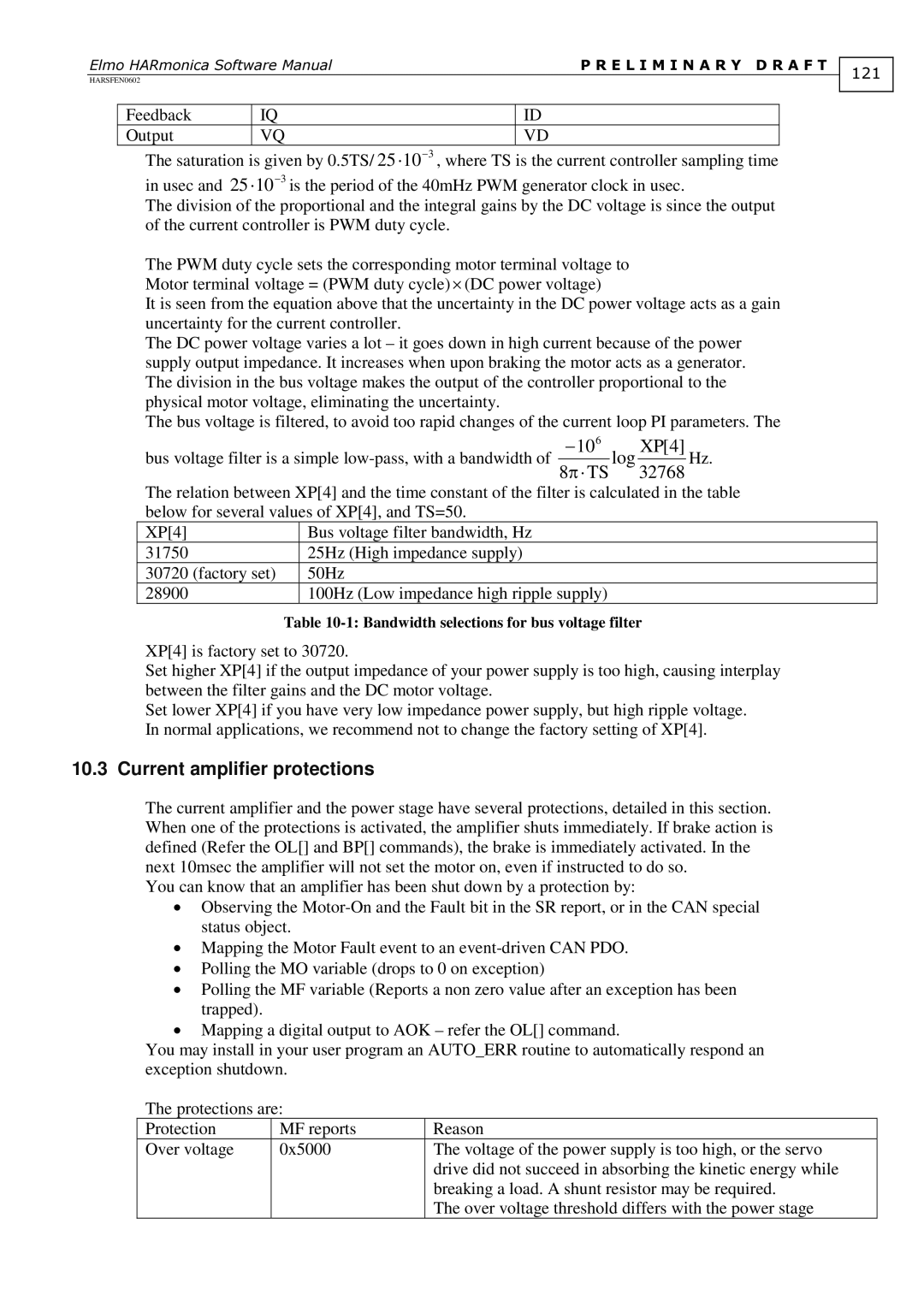|
|
|
|
|
|
|
|
HARSFEN0602ElmoHARmonicaSoftwareManual | PRELIMINARYDRAFT |
|
|
| |||
|
|
|
|
|
| 121 |
|
|
|
|
|
| |||
|
|
|
|
|
| ||
| Feedback | IQ | ID |
|
| ||
| Output | VQ | VD |
|
| ||
The saturation is given by 0.5TS/ 25⋅10−3 , where TS is the current controller sampling time
in usec and 25⋅10−3 is the period of the 40mHz PWM generator clock in usec.
The division the proportional and the integral gains by the DC voltage is since the output of the current controller is PWM duty cycle.
The PWM duty cycle sets the corresponding motor terminal voltage to | |
Motor terminal voltage = (PWM duty cycle) | (DC power voltage) |
| × |
It is seen from the equation above that the uncertainty in the DC power voltage acts as a gain | |
uncertainty for the current controller. |
|
The DC power voltage varies a lot – it goes down in high current because of the power supply output impedance. It increases when upon braking the motor acts as a generator. The division in the bus voltage makes the output of the controller proportional to the physical motor voltage, eliminating the uncertainty.
The bus voltage is filtered, to avoid too rapid changes of the current loop PI parameters. The
| −106 | log | XP[4] | ||
bus voltage filter is a simple |
|
| Hz. | ||
8π ⋅ TS | 32768 | ||||
|
|
| |||
The relation between XP[4] and the time constant of the filter is calculated in the table below for several values of XP[4], and TS=50.
XP[4] | Bus voltage filter bandwidth, Hz |
31750 | 25Hz (High impedance supply) |
30720 (factory set) | 50Hz |
28900 | 100Hz (Low impedance high ripple supply) |
Table
XP[4] is factory set to 30720.
Set higher XP[4] if the output impedance of your power supply is too high, causing interplay between the filter gains and the DC motor voltage.
Set lower XP[4] if you have very low impedance power supply, but high ripple voltage. In normal applications, we recommend not to change the factory setting of XP[4].
10.3 Current amplifier protections
The current amplifier and the power stage have several protections, detailed in this section. When one of the protections is activated, the amplifier shuts immediately. If brake action is defined (Refer the OL[] and BP[] commands), the brake is immediately activated. In the next 10msec the amplifier will not set the motor on, even if instructed to do so.
You can know that an amplifier has been shut down by a protection by:
Observing the
Mapping the Motor Fault event to an
Polling the MF variable (Reports a non zero value after an exception has been
•trapped).
Mapping a digital output to AOK – refer the OL[] command.
You may install in your user program an AUTO_ERR routine to automatically respond an exception shutdown.
The protections are:
Protection | MF reports | Reason |
Over voltage | 0x5000 | The voltage of the power supply is too high, or the servo |
|
| drive did not succeed in absorbing the kinetic energy while |
|
| breaking a load. A shunt resistor may be required. |
|
| The over voltage threshold differs with the power stage |
